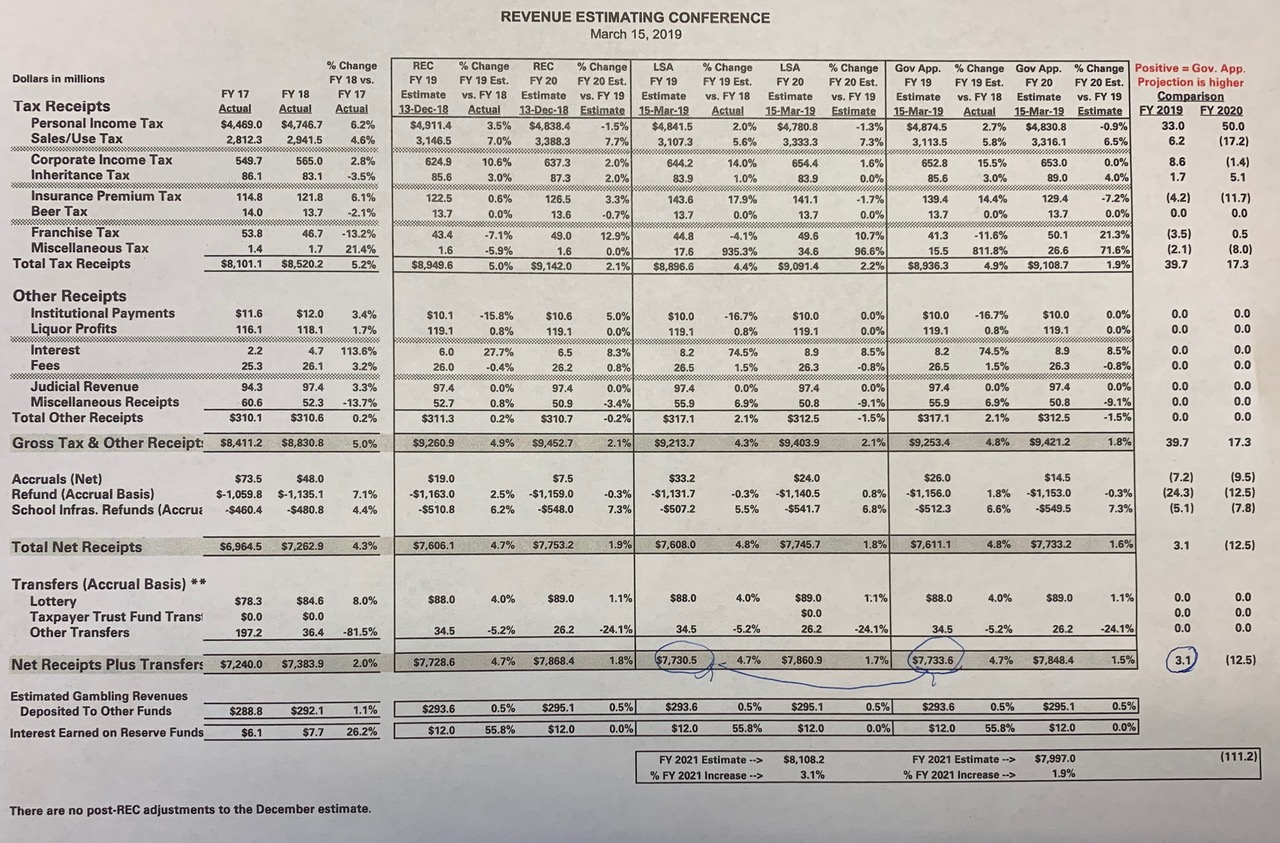
The Revenue Estimating Conference ("REC") met yesterday morning (3/15/19) in Des Moines. A short summary of the information discussed during the meeting is below, along with the below spreadsheet handed out during the meeting that contains more detailed information. In short, the report from yesterday shows that revenues for the existing fiscal year (FY19) are up slightly ($5M) and revenues projected for the upcoming fiscal year (FY20) are down slightly ($20M) as compared to December 2018 estimates.
Important to Note: Yesterday’s REC number is purely an estimate and used by the legislature to help develop future budgets. Recall, the Governor uses the December 2018 estimate to prepare her budget, which was introduced on January 15, 2019 and found here. The Legislature is required to use the lower of the December 2018 and March 2019 estimates for its upcoming fiscal year (“FY”) 2019 budgeting. As explained in detail below, because the March 2019 estimate is $20M lower than the December 2018 estimate, the legislature is required to use yesterday’s estimate.
General Comments From the REC Regarding Factors Impacting State Revenues:
- Iowa’s unemployment rate remains incredibly low, 2.4% (it was 2.8% on year ago);
- Approximately 22,500 more Iowans are working today (1,654,400) as compared to one year ago (1,631,900) - read more here;
- Wage growth is increasing in Iowa, but lags behind the remainder of the Country;
- Very close to reaching the longest economic expansion in history;
- Expansion of sales tax revenues due to the new Iowa sales tax law adopted in 2018 is projected to increase FY19 revenues by $79M;
- We’re getting closer to year around e-15, so that will relieve some pressure on agriculture commodities;
- The United States-Mexico-Canada Agreement (“USMCA”) is positive for Iowa as we export to 180 countries and 50% of our exports go to Canada and Mexico;
- China tariffs appear to be heading in right direction. If this does get resolved, we will see fortunes of agriculture turn around quickly. A lot of grain in storage waiting to be sold at the right price;
- The National economy slowed in 2018; finishing GDP at 2.6% for the fourth quarter;
- Unemployment claims have ticket up slightly and consumer confidence remains high, but is down slightly from its peak;
- While abundant employment opportunities exist (55,000 opening in Iowa), there is a significant shortage of skilled or qualified workers in Iowa;
- If we had 55,000 more people that were working, that would have a big impact on state revenues. Even when you factor in that wages are going up, still not going up at the rate to compensate if businesses had 55,000 more people working;
- Crop prices remain depressed and grain inventories are large;
- Iowa leading indicators fell for 4th consecutive month - an early signal of recession;
- New housing starts are slowing;
- Iowa State University has said that land values have dropped 2.7% and this is one of the numbers we watch most carefully; and
- We’re looking at more of a slowdown at this point than three months ago (during the December 2018 REC meeting).
FY19 Revenues Revised Up from December 2018 Estimate:
- As a reminder, FY19 ends June 30, 2019. The REC slightly increased its December 2018 estimate for FY19 by $5.0 Million dollars. This slight increase equates to projected Net Receipts of $7,733.6 billion, which reflects 4.7% growth in FY19 as compared to FY18. In terms of “new" dollars, as compared to FY18, these numbers reflect a projected increase of $349.7 million in revenues as compared to actual FY18 revenues.
FY20 Revenues Revised Down From December 2018:
- As a reminder, FY20 begins on July 1, 2019 and ends June 30, 2020. The REC slightly revised down its December 2018 estimate for revenue growth in FY20 over FY19 to 1.5% growth as compared to 1.8% projected in December. Yesterday's revised estimate means FY20 revenues are estimated to be $7,848.4 (an increase of $114.8 million over FY19 estimated revenues). For budgeting, the legislature is required to use the lower of the December 2018 and March 2019 estimates, which means, the legislature is required to budget off of yesterday’s estimate of $7,7848.4 for its upcoming appropriations and budgeting process.
FY21 Revenues Estimated For First Time:
- As a reminder, FY21 begins on July 1, 2021 and ends June 30, 2022. The initial estimate, which is admittedly 27 months out, shows revenue growth at a 2.6% increase over the estimated FY20 revenues, which equates to total revenues of $8,050.
